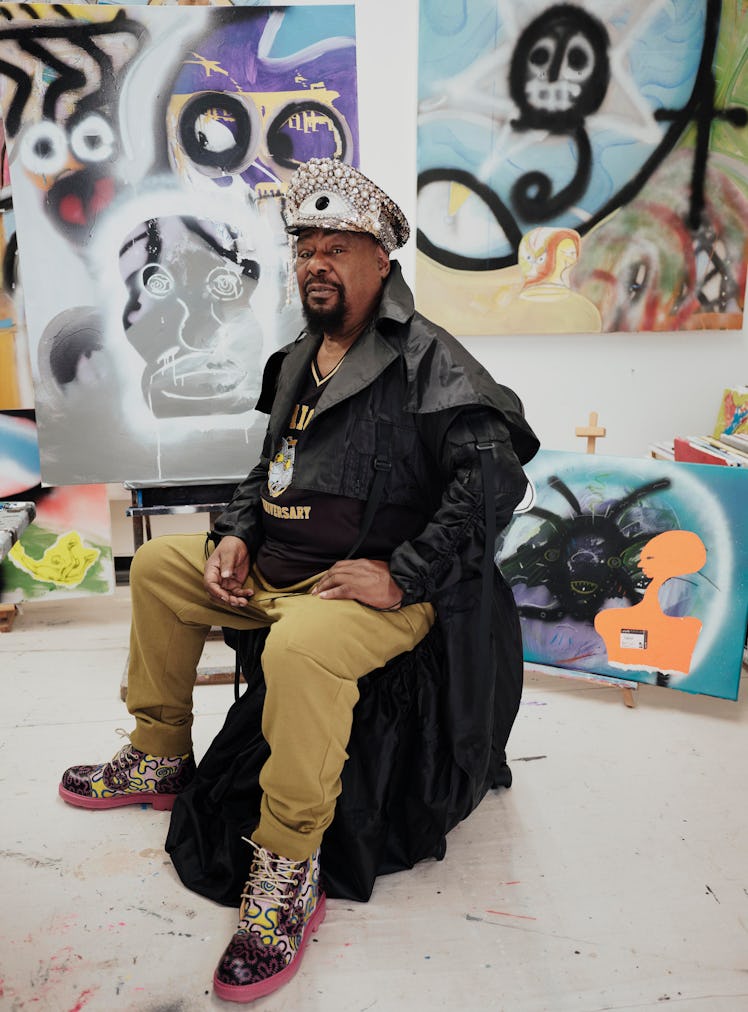George Clinton Keeps the Funk Flame Alive
The 81-year-old godfather of funk talks style, creativity, and planetary harmony.

Prince inducted your bands, Parliament and Funkadelic (or P-Funk), into the Rock & Roll Hall of Fame over a quarter century ago, but it’s only now, at 81, that you’re getting the biopic treatment with Wiz Khalifa, who plays you in Spinning Gold, about the early days of Casablanca Records. What’s it like to look back on that time through the eyes of younger artists?
Wiz Khalifa was pretty aware of the music through his parents, but he didn’t know the details. In fact, I just did another movie, Agent Elvis, about Elvis Presley, that’s animated.
Your career started when you were a teenager, with the Parliaments, a doo-wop band in suits and ties. What prompted the shift in your sartorial sensibility?
That was ’68. We went from wearing suits and coconut hairdos to diapers and sheets. When we got our first hit record, (I Wanna) Testify, we started seeing people with the flower shirts and the psychedelic stuff. We had to play with a lot of those groups that looked like that, so we changed into Funkadelic. By ’69, we were singing “Free Your Mind...and Your Ass Will Follow.”
Before Parliament blew up, you worked as a hairdresser. You had multicolored braids and a bright pink mohawk.
I was doing hair in Plainfield, New Jersey. Silk Palace was my barbershop. On Saturdays, there’d be Cadillacs three deep outside with all these musicians, preachers, politicians. Jackie Wilson and Sam Cooke came through. Being a hairdresser, you learn that styles come and go. I knew what was happening, how to make something weird happen or be futuristic. You go back far enough, you still out front.
As your alter ego, Dr. Funkenstein, you would land onstage from an extraterrestrial mothership, wearing everything from sparkling capes and boa-trimmed tricorn hats to wedding dresses. Where would you source those looks?
By the time we got ready to do the mothership, it was about Broadway. So we got Jules Fisher to build a spaceship, and Larry LeGaspi dressed me. He did a lot of the Broadway costumes. It was a space pimp look—fur coat, ermine tails, nine-inch boots.
Did you ever work with fashion designers, or is most of the stuff in your closet one of a kind?
It was one of a kind for all the different characters—Dr. Funkenstein and Sir Nose—but our street clothes were pretty costumey too. We would go to the vintage shop Paul Sargent, on West Fourth Street, down in the Village. It was real slick—we wore a lot of leathers, patchwork, and deerskin coats. When we got really into the psychedelic era, I used to wear a sheet, no shoes, everywhere I went for about a year or two. I was completely outta my mind.
Sounds like you were turning on.
I was turning off, on, and out.
You said recently that Wiz Khalifa made you look like Bootsy Collins, one of your former bandmates, in the film. So who had better style, you or Bootsy?
Well, Bootsy was style. He was stylish just to look at. That’s why he ended up in his own group. He played with us for a minute, but he’s so dynamic—six feet something, the star glasses.
A few months ago, you had a big exhibition, “George Clinton: The Rhythm of Vision,” of sculpture and paintings—mainly depicting motherships, Dogon-inspired people, and some pimplike dog creatures—at Jeffrey Deitch gallery in Los Angeles. What’s your process like in your Tallahassee studio?
I’m up at seven o’clock, the same way I used to do when I’d go in the studio to record music. I’m always listening to the music that I just recaptured the copyright to, so there’s an enthusiasm as I play those old songs, and I’m just as inspired by that as I was when I first got started. It actually makes me feel much younger. Right now there’s a lot of alien references, these balloons that’s going around. I think somebody might be sending those things. A lot of that is influencing my thoughts and what I’m doing on canvas.
You’ve collaborated with so many progressive artists over the years, from Overton Loyd, who paints with you and has created the visual aesthetic for the band for decades, to Red Hot Chili Peppers bassist Flea and the young visual artist Lauren Halsey, who designed a stage for your Deitch show. Is there anyone you’d still like to collaborate with?
Smokey Robinson, Rakim, and Eminem. In Detroit, Eminem’s first producer was the Bass Brothers. I produced them, and they produced my son. So I’ve known him since before his first record came out, and he’s been good like that forever, so I’ve got lots of respect for him. Rakim has always been my favorite rapper; he was the one who made me wanna learn how to do it. And Smokey Robinson has been my songwriting hero from day one.
On Parliament’s 1975 album Mothership Connection, you sing, “You’ve got all that is really needed / To save a dying world from its funkless hell,” on the song “Unfunky UFO.” It’s become an anthem of Afrofuturism, but with all the war and division going on right now, can we still save this planet from its funklessness?
I’m hoping someone will land on this planet to intervene and show us the key is getting together as one whole planet. That is the challenge. Somebody’s got to come and give us that harmony that’s needed. But we got to jump the planet. I’m planning on going on one of these rides with Elon Musk by the end of the year.
So one planet under a groove?
One planet under a groove.
This article was originally published on